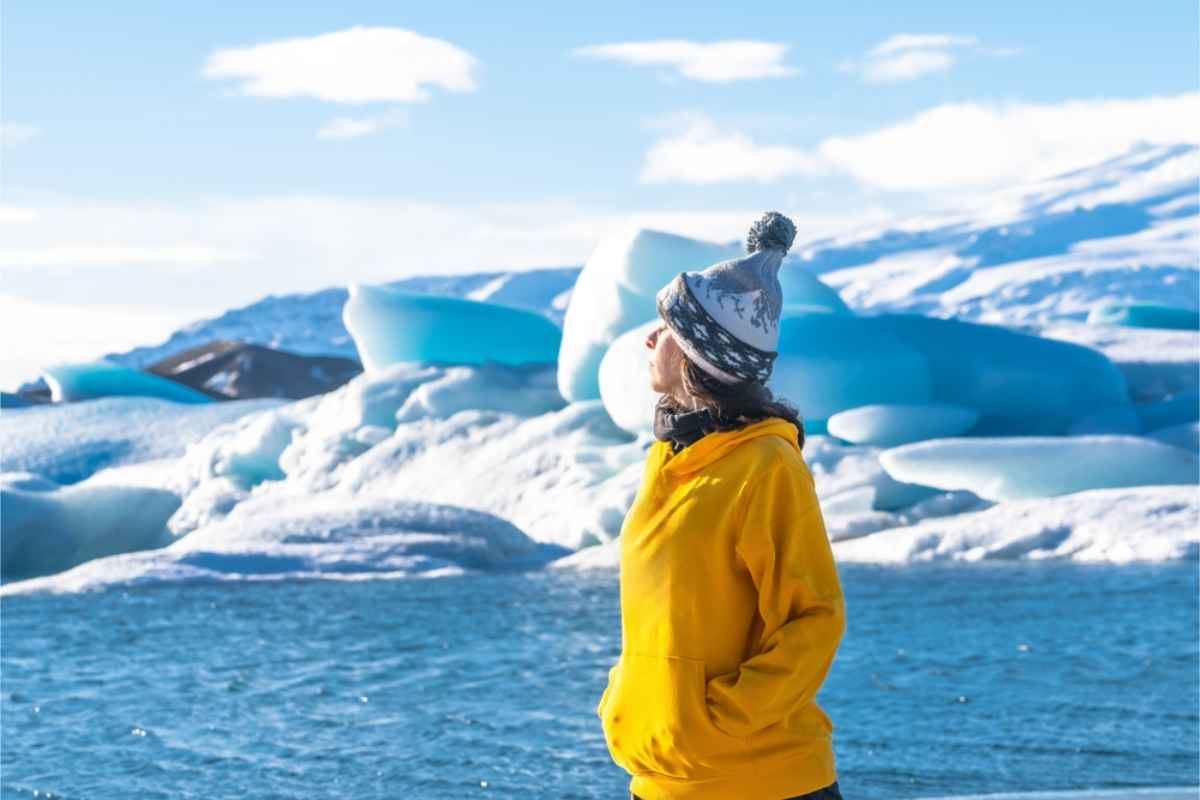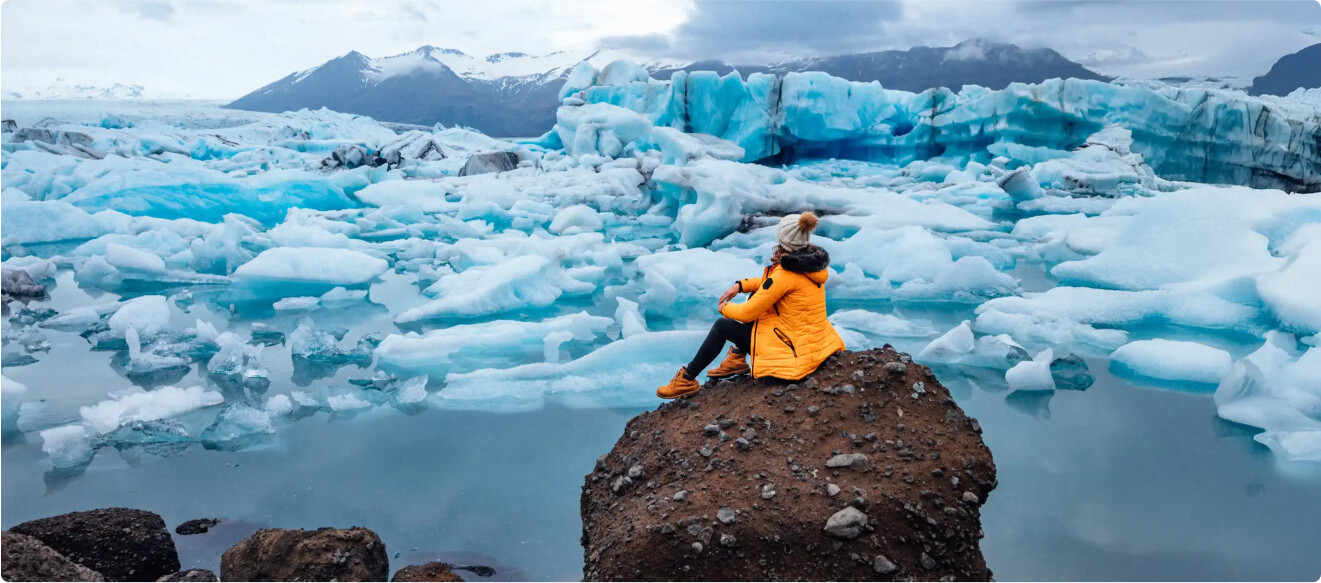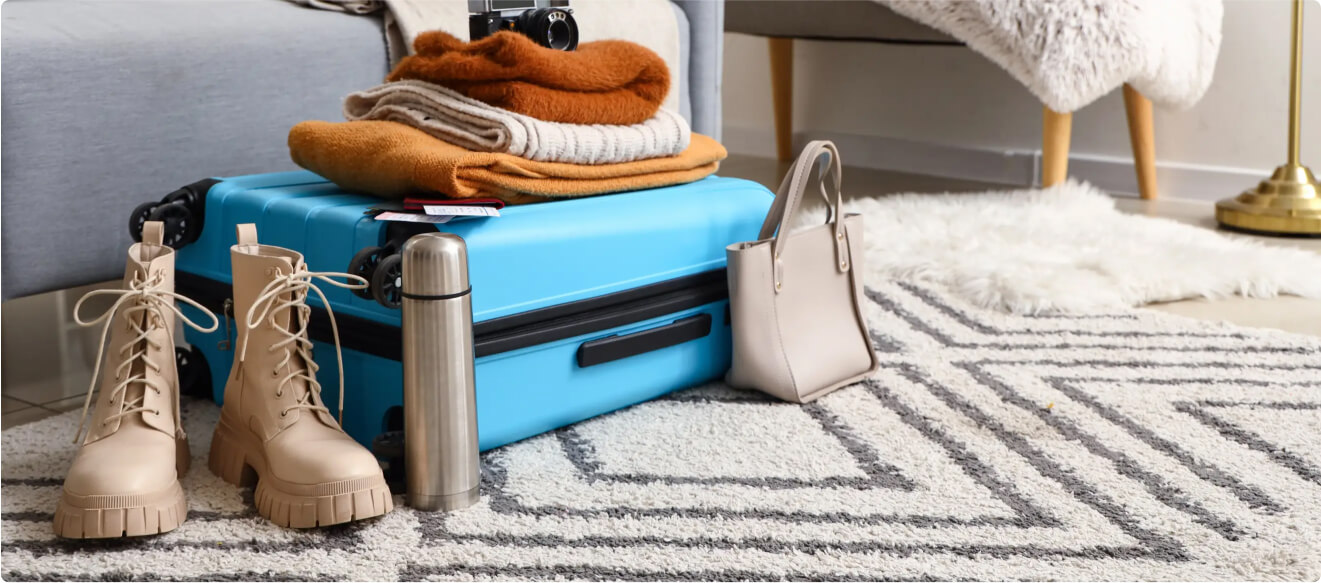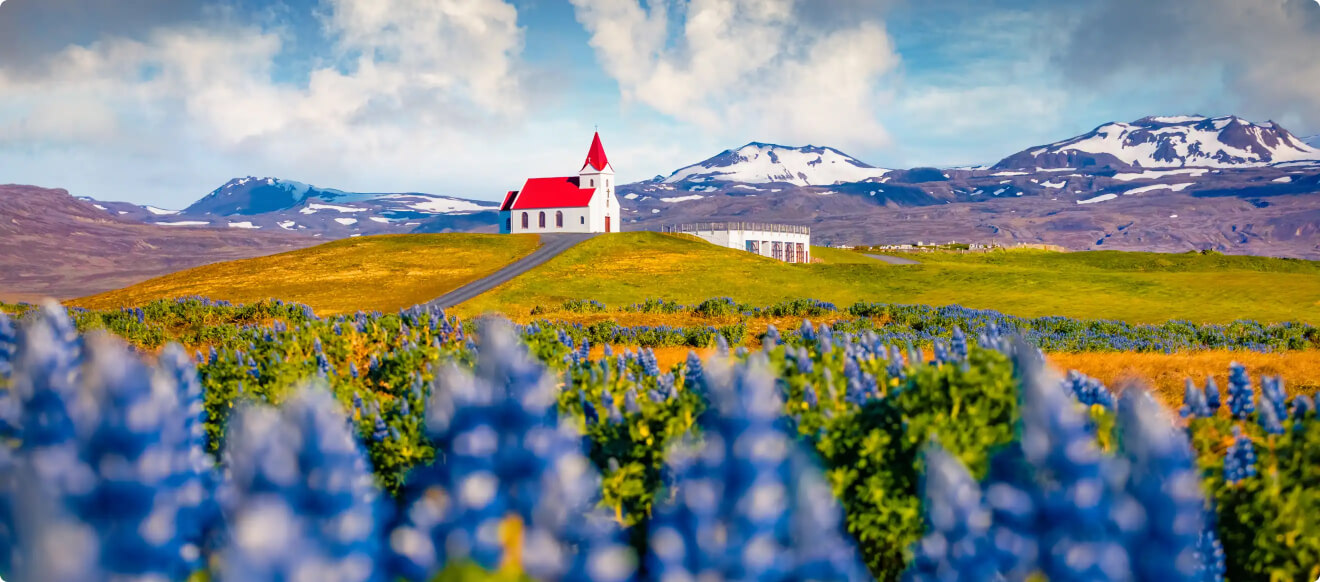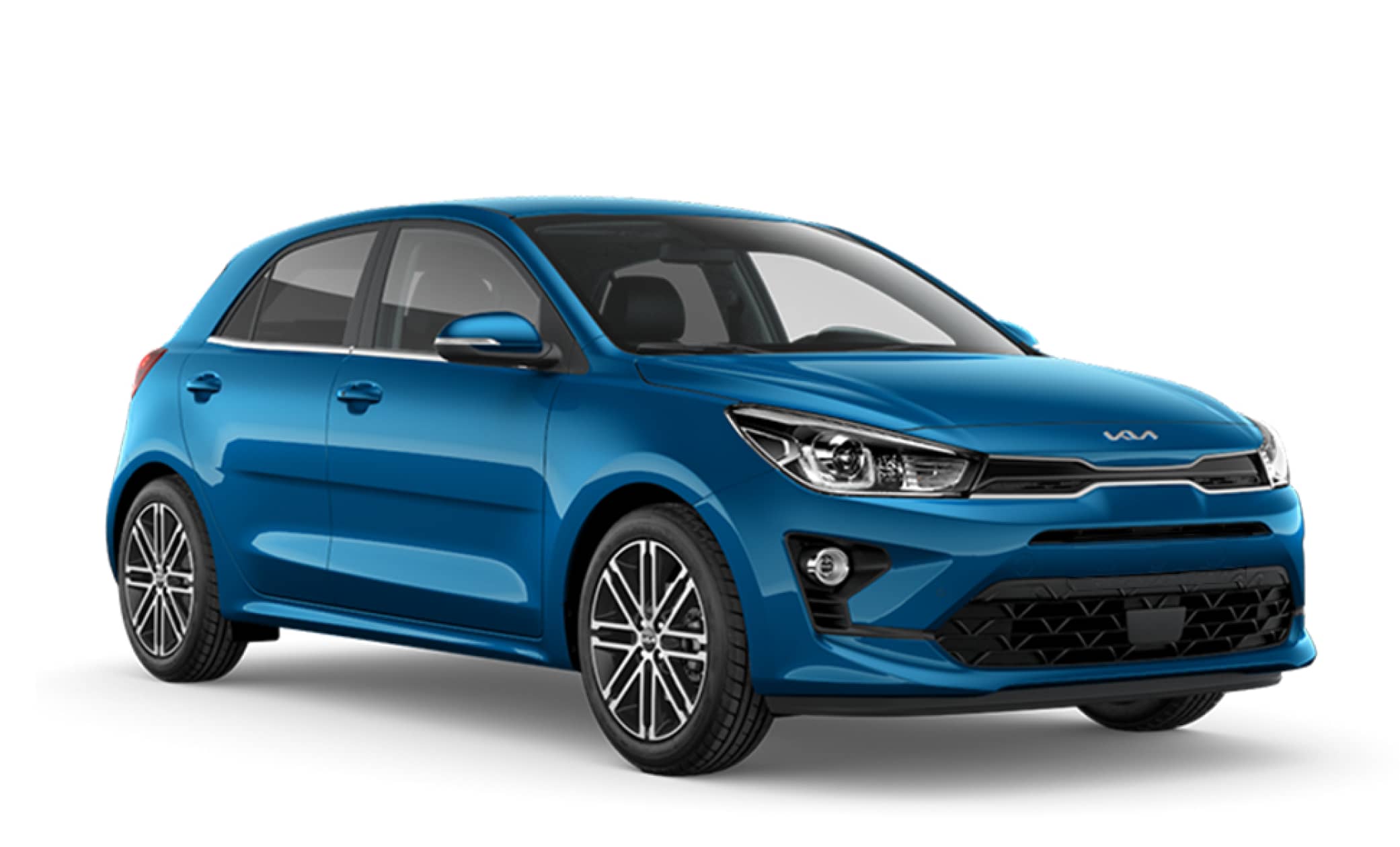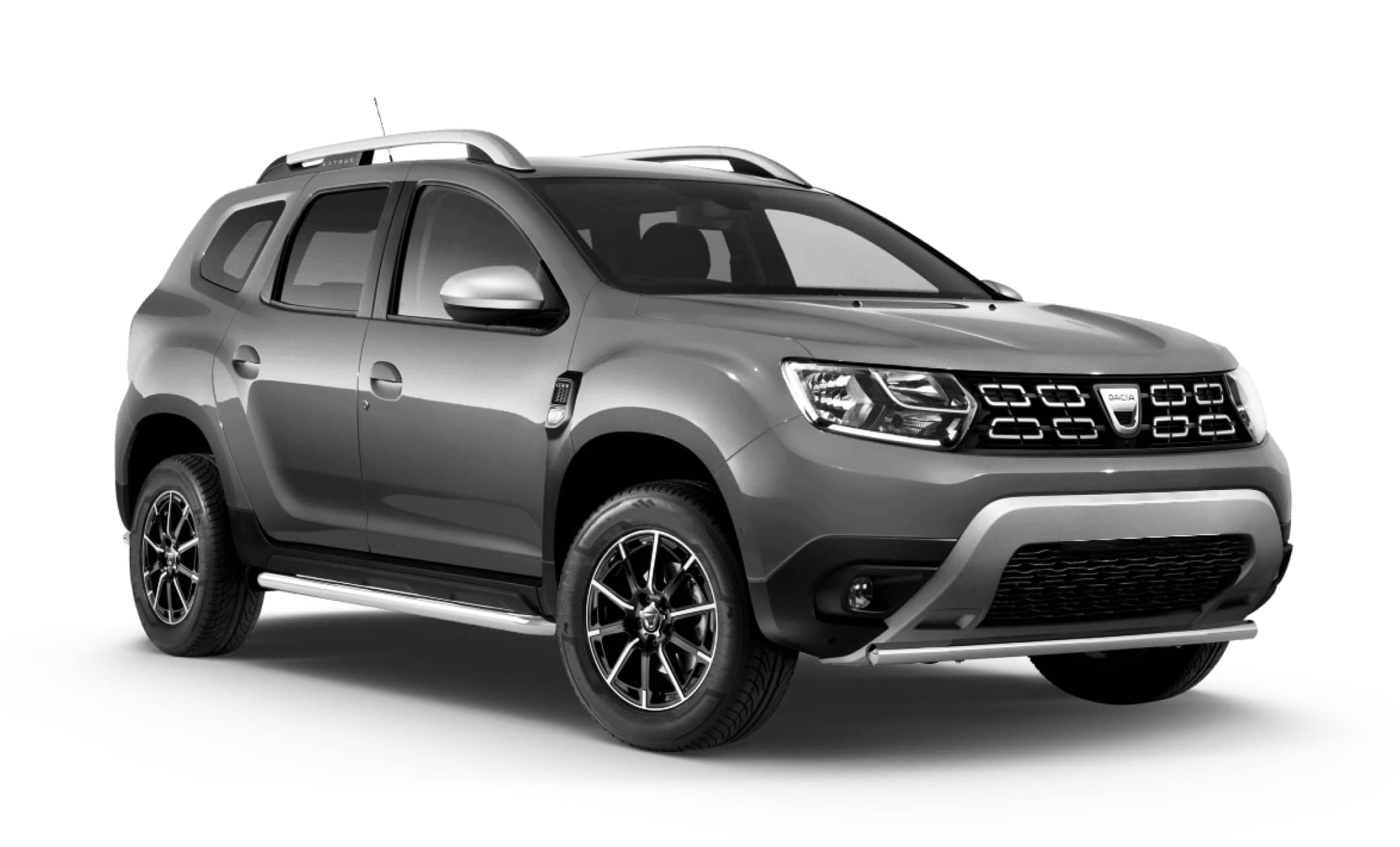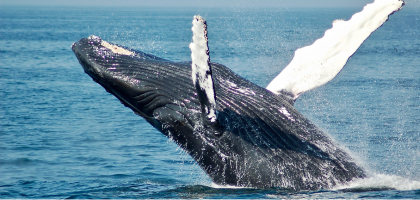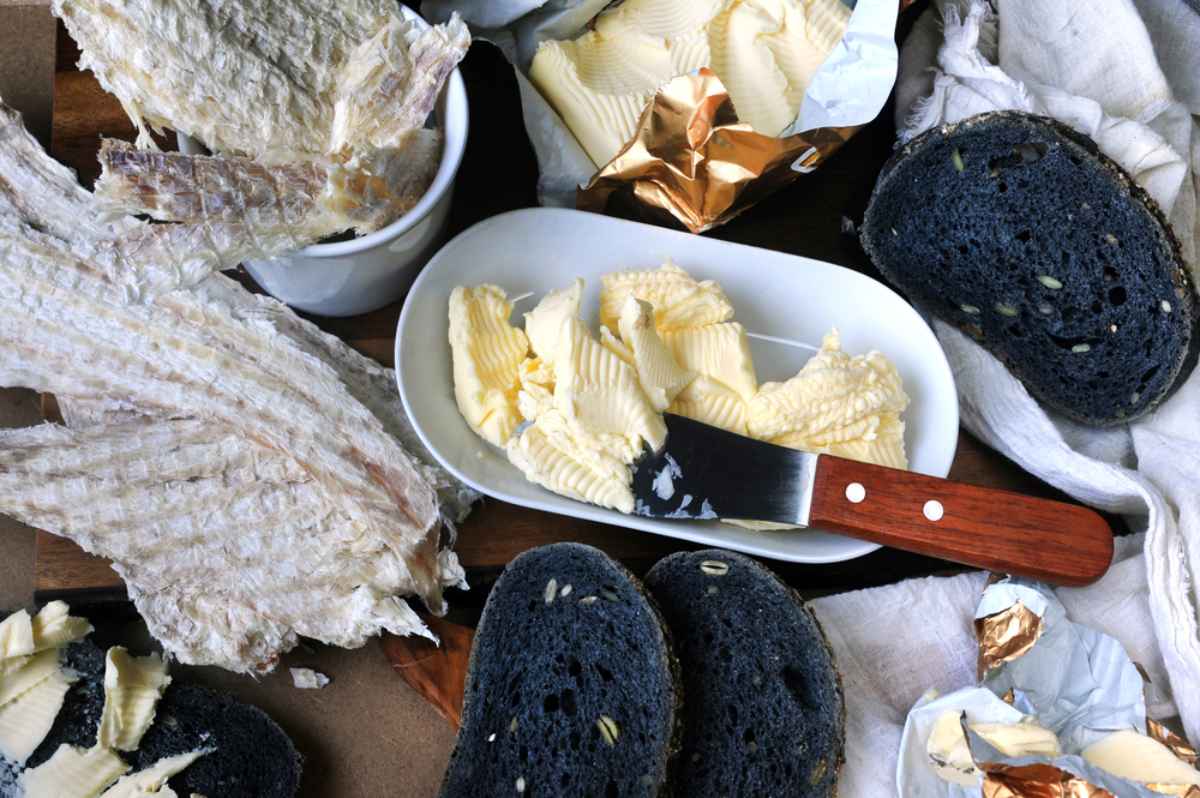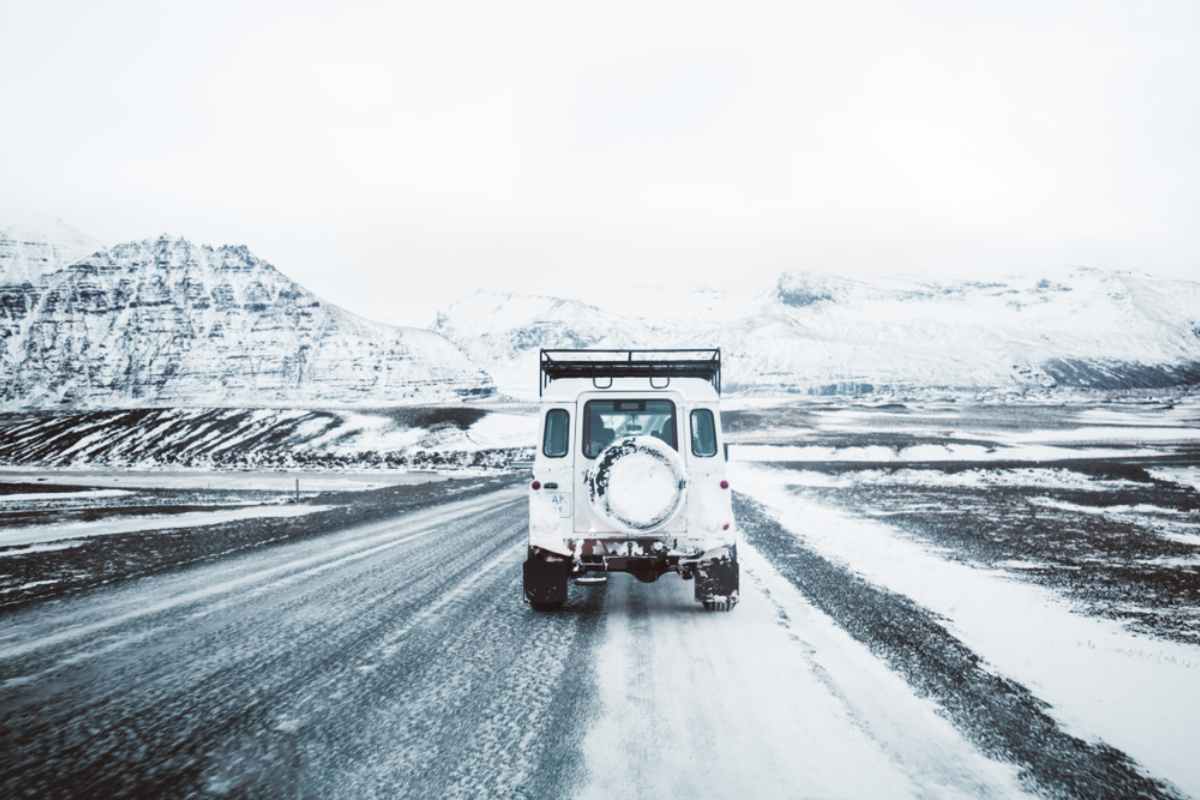Driving in Iceland during winter sounds reckless at first glance. Snow, ice, winds that could knock a hat clean off. Yet this is where the magic hides. Roads that feel like private runways through white silence. Freedom to stop where buses never even blink. And bragging rights when you roll home with Northern Lights on your camera instead of stories about queuing for someone else’s schedule.
This Iceland winter itinerary is built for travelers who’d rather hold the steering wheel than shuffle after a guide. Renting a car in Iceland means independence, not indulgence. You decide when to pull over, when to leave, and when to linger. That choice alone changes the trip.
What does the payoff look like? Waterfalls rimmed in ice, spray freezing on your jacket. Black sand beaches get hammered by the Atlantic so much that it feels staged. Ice caves glowing blue like someone cranked the saturation dial too far. All of it visited on your terms, not when a whistle blows.
This 5-day route takes you through Reykjavík’s culture, the Golden Circle, South Coast monsters like Skógafoss, plus the rarest winter perks: chasing auroras and stepping inside glaciers. We’ll cover when a normal car works, when a 4x4 saves your skin, and the road tricks locals actually use.
If you want hand-holding, book a tour. If you want freedom and a story worth telling, keep reading.
Why Winter is the Best Time for a Road Trip in Iceland
Iceland in winter is stripped down to bone and beauty. Black lava under white snow. Glaciers glowing in dim light. Around the solstice, you get four to five hours of daylight, but every edge of it stretches into a surreal, endless dawn. It feels like driving through one long sunrise that refuses to fully wake up. Popular sites feel half-abandoned, silence swallowing the usual chaos.
Wildlife and Frozen Giants
Winter isn’t dead space. The Arctic fox prowls the snow, white fur blending into drifts. Seabirds still wheel along fjords. And waterfalls don’t just flow, they armor themselves in ice. Gullfoss looks like it’s wearing steel plating. Seljalandsfoss turns into a frozen chandelier. These shapes don’t exist in July.
Winter Exclusives
The season unlocks things you won’t touch in summer in Iceland. Ice caves form only when cold seals the glacier walls tightly. Inside, the light is blue glass bent into a cathedral. And then there’s the aurora. Long nights give you a fighting chance to see streaks of green and pink burn across the sky.
December’s Edge
Iceland in December is the peak of extremes. Longest nights. Deepest cold. The sky itself feels like it’s made for aurora hunters who don’t want to wait until midnight. Average temperatures hover near 0°C (32°F), but wind can make it feel far worse.
Snow and sleet swap places with sudden gales, all in one day. It’s unpredictable, but that’s half the draw. If you’re not comfortable with chaos, winter driving here will grind you down. If you are, it rewards you with moments people in summer never see.
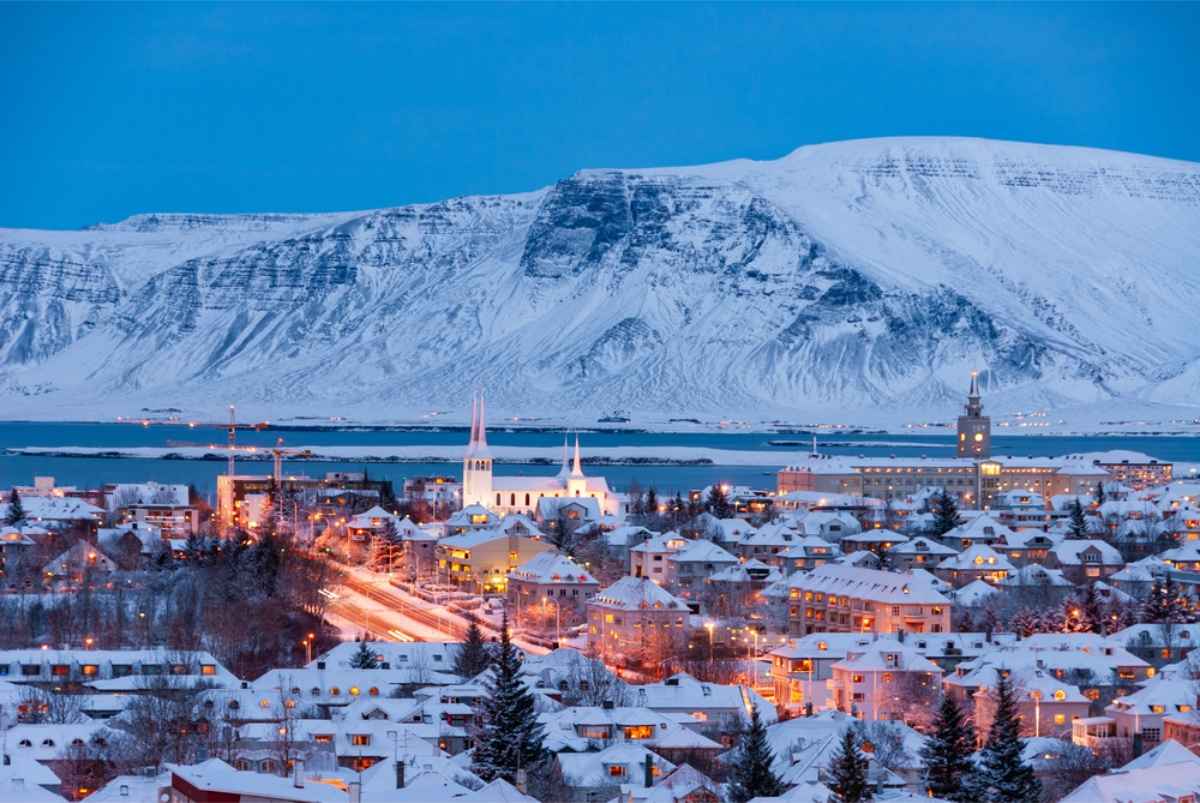
Should You Rent a Car in Iceland in Winter?
Yes, obviously, you should rent a car in Iceland in winter. Here’s why driving yourself is the only move that makes sense.
Benefits of Driving Yourself
July drains wallets. February looks the other way. Car rental rates dip, hotel rooms drop, and you can actually walk into a restaurant without booking three days ahead. Two people in a compact car pay less than two tickets on a Golden Circle bus. Let’s take a more in-depth look at some of the other perks of self-driving:
Control Your Pace
This isn’t a classroom field trip. With your own wheels, you call the shots. Stop at that frozen waterfall. Skip the tourist mob if it’s not your vibe. Linger in golden light while it lasts, which in winter means every single minute counts. Daylight is short, four to six hours in deep season, so making your own schedule is survival, not indulgence.
Access Off-Peak Gems
Tour buses don’t bother with lonely fjords, half-hidden hot springs, or gravel pullouts that look unimportant until the Northern Lights explode overhead. With a car, you can detour into those corners. Some ice cave meeting points can’t even be reached without driving yourself. That’s how an Iceland in winter itinerary becomes more than the brochure route.
Cost Efficiency When Split
Tour operators charge per head. Cars charge per car. Four people in one rental share fuel, split the price, and laugh at what the same journey would have cost through a tour. Families or groups get freedom and still keep their wallets intact.
Comfort and Warmth
Iceland in winter isn’t a place to wait outside shivering while a guide counts heads. Your car is your heated bunker between photo stops. A place to eat snacks, peel off wet gloves, and reset before heading back out. Essential when wind chill drops far below 0°C (32°F) and feels like the Arctic is testing your patience.
Optional Spontaneity
Rigid tours rush you along. Driving yourself means detours when the weather looks better in another valley, or when you spot a side road leading to something unplanned. Some of the best memories come from those wrong turns.
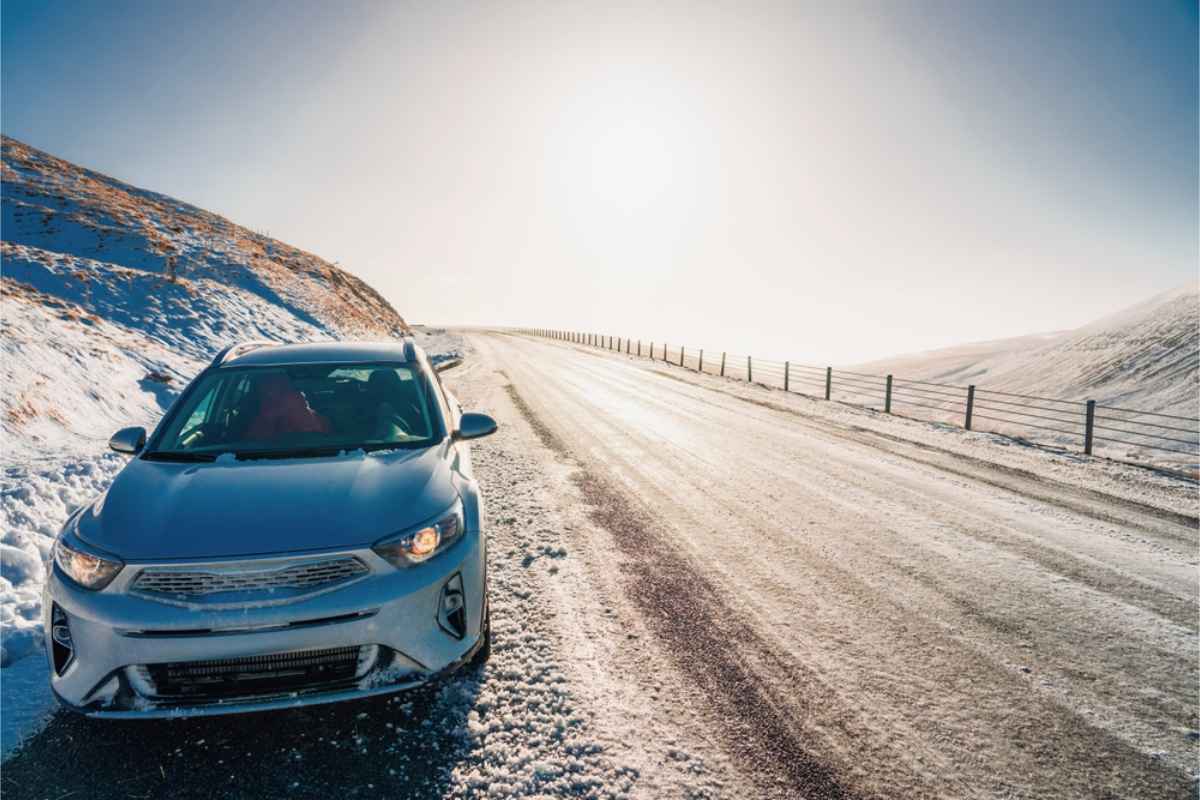
What Type of Rental Car Do You Need?
Pick the wrong car in winter, and your Iceland winter itinerary goes from adventure to headache fast. The choice isn’t about style, it’s about survival and access.
When a 2WD Is Enough
If you’re staying close to Reykjavík or looping the Golden Circle, a 2WD compact will usually do the job. Roads here are plowed often, surfaces are paved, and traffic keeps them clear. On mild winter days, a small car saves money and fuel.
Why 4x4 Is Best for South Coast or Icy Roads
The South Coast is another beast. Black ice, drifting snow, and long stretches without services mean a 4x4 isn’t a luxury; it’s a necessity. Higher clearance handles snow piles, traction systems bite into ice, and the extra stability matters when winds try to push you sideways. Venture off the main routes or toward gravel stretches, and a 2WD won’t just struggle; it may void your insurance entirely.
Tire Types
From November 1 to April 15, winter tires are the law. Our rentals come fitted with them at no extra charge to you. Two main options: studded tires with metal spikes for maximum grip on ice, or friction tires that ride quieter but slide easier. Chains aren’t legal in Iceland, so spikes are your best friend when the South Coast turns slick.
Insurance Add-Ons That Matter
Every one of our rentals already comes with a safety net. CDW, SCDW, GP, and TP are included for free. That means bodywork, glass, mirrors, gravel chips, and even theft are covered from day one. Iceland is safe, sure, but the roads don’t care. Here’s what you can expect from our car rental insurance packages:
Automatically Included Insurances
- Collision Damage Waiver (CDW) - Covers the vehicle’s bodywork. Basic third-party liability included.
- Super Collision Damage Waiver (SCDW) - Higher cover with a deductible cap of 90,000 ISK on 2WD and 120,000 ISK on 4WD.
- Gravel Protection (GP) - Common sense in Iceland. Pays for paint, windshields, headlights, and mirrors. Deductible capped at 40,000 ISK.
- Theft Protection (TP) - Covers the vehicle if it’s stolen. No deductible, though it doesn’t cover what’s inside.
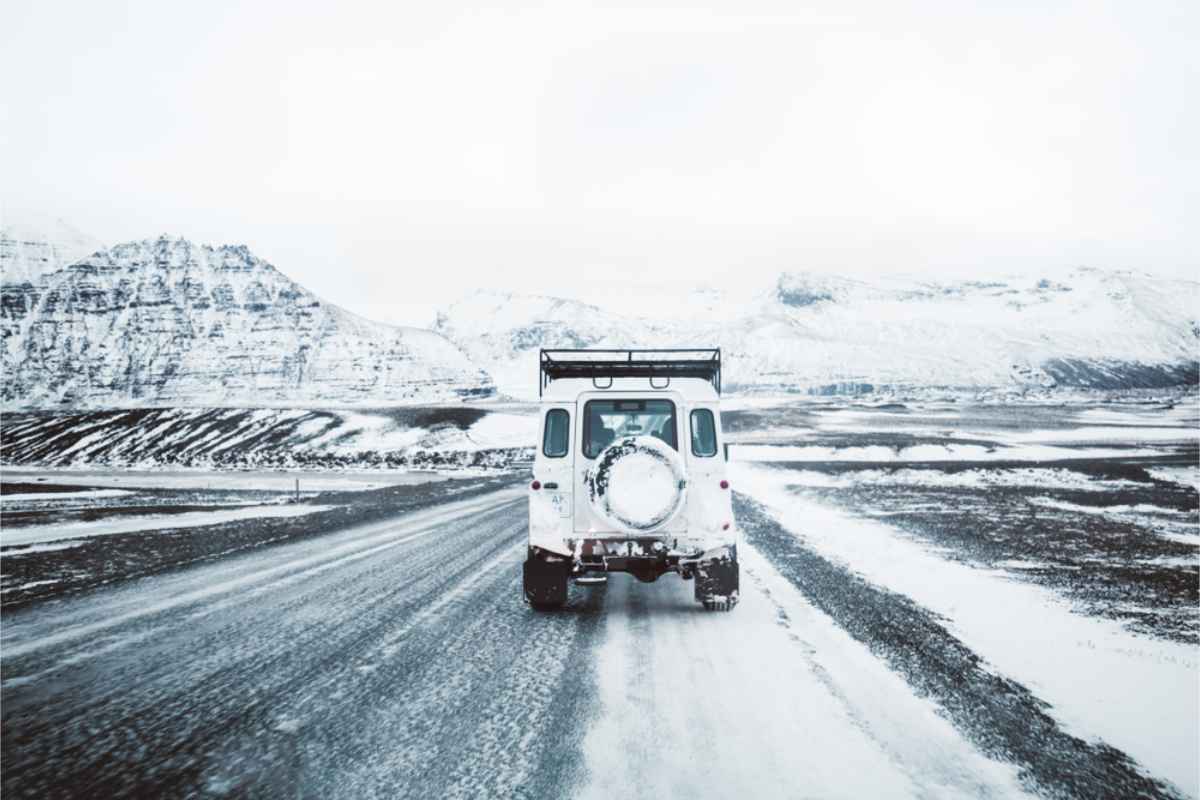
Optional Insurances
- Liability Waiver - Drops the deductible of all included insurances to zero. Also covers underside damage, wind-bent doors, and water damage. Price depends on vehicle size. About 4,200 ISK per day.
- Sand and Ash Protection (SAAP) - Covers damage from volcanic ash, pumice, gravel, or sandstorms. Think paintwork, glass, wheels, plastics. Deductible capped at 90,000 ISK. Around 1,050 ISK per day.
Optional coverage usually runs between 15 and 35 USD (roughly 2,000 to 4,500 ISK) daily, depending on vehicle size and plan. Small cost. Big relief when a storm kicks up.
Winter Driving Tips for Safety
Driving in Iceland in winter is not a casual Sunday spin. It’s survival with scenery. If you want your Icelandic itinerary for winter to actually happen, treat the road like a living thing that can turn against you without warning.
Bridges and Blind Hills
Icy bridges freeze first. Blind summits hide slick patches until you’re already on them. Slow down before, not during. Keep steering smooth, brakes gentle, and expect black ice you cannot see.
Reading the Signs
Iceland’s road signs are yellow, blunt, and sometimes brutally honest. One lane. Blind rise. Gravel ahead. Learn the symbols, because many warnings are in Icelandic. Avalanche markers or single-lane bridges demand more than casual attention. Missing them is how accidents start.
Pack an Emergency Kit
A winter kit is not optional. Think first aid, hi-vis vest, reflective triangle, shovel, thermal blanket, extra warm layers, food, water, and light. Add microspikes if you step out on ice. Carry a charged phone and power bank, because dead batteries are useless in the dark.
Know When to Stay Put
Some days, Iceland doesn’t want you on the road. Severe storms, heavy snowfall, or 30 m/s winds (about 65 mph) on exposed roads make driving reckless. If Umferdin marks it closed, respect it. Waiting in a safe guesthouse is smarter than becoming a headline.
Day 1: Arrival in Iceland and Blue Lagoon or Sky Lagoon
The first day on a 5-day Iceland itinerary in winter isn’t about covering distance. It’s about setting rhythm. Pick up the car, test your winter driving nerves, soak in a lagoon, and eat like a local.
Keflavík Airport Arrival and Car Pick-Up
Arriving at Keflavík International Airport is straightforward, but the real trip starts the second you hit the rental desks. They sit just outside the terminal after luggage claim. Pre-booking is smart. Iceland’s winter isn’t the time to gamble on walk-ups.
Before you even turn the key, inspect the car like a detective. Photograph every scratch, chip, or dent. Windows, mirrors, headlights, paint. It takes five minutes and saves hours of arguments later. It also forces you to get familiar with the car before meeting Icelandic weather.
The drive from Keflavík to Reykjavík is simple on paper, about 50 km (31 miles), but it introduces you to the country’s tricks: sudden wind gusts across open lava fields, patches of black ice, and light snow flurries that hide the road’s edges. Go steady. This first stretch isn’t about speed; it’s about learning how your rental responds when the elements push back.
Relaxation in a Hot Lagoon
First stop: a hot soak. You’ve got two main options.
The Blue Lagoon is closest, carved into a lava field just minutes from the airport. Milky blue water, minerals thick enough to leave your skin squeaky, and a reputation that guarantees crowds. It is iconic for a reason and a surreal way to thaw after a flight.
The Sky Lagoon waits on the edge of Reykjavík. Built right against the ocean, it trades fame for intimacy. Traditional Icelandic design, fewer bus groups, and infinity views over the sea. It feels calmer, almost private, compared to the Blue Lagoon’s spectacle.
Having a car means you choose. Land in the morning? Blue Lagoon makes sense on the way. Arriving later? Drive straight to Reykjavík and ease into the Sky Lagoon.
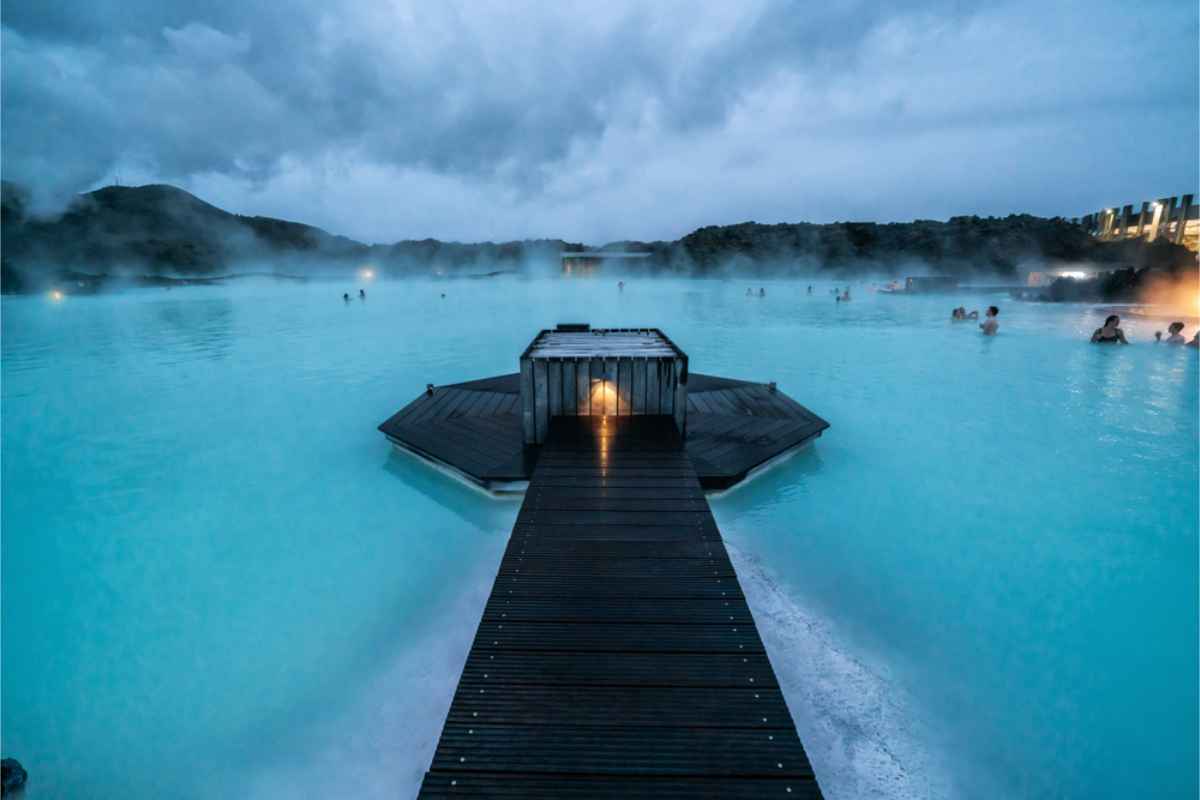
Dinner in Reykjavík
Reykjavík splits visitors fast. Downtown menus lure tourists with whale steak and puffin platters at three times the fair price. Your rental car lets you dodge the traps and head where locals actually eat.
In Vesturbær, check Matarbúrið for hearty fish dishes or Kaffihús Vesturbæjar if you want casual Icelandic comfort food without ceremony. Both are warm, unfussy, and filled with locals after work.
In Grandi, the harbor district, Grandi Mathöll is a food hall packed with small vendors serving everything from lamb stew to Icelandic street food. Want something classic on the outskirts? Ægisgarður Brewpub pours local craft beer with fish and chips that can handle the cold. Or head to the old harbor for Sægreifinn (Sea Baron) and the lobster soup that locals still swear by.
If you’re visiting around Christmas time, the Reykjavík Christmas food tour adds a seasonal twist, with holiday dishes and festive drinks you won’t see the rest of the year. With wheels, you can reach it all, park nearby, and leave when you’re ready, not when taxis happen to be available.
Day 2: Reykjavík Highlights and Northern Lights Hunt
An Icelandic December itinerary doesn’t let you waste daylight. Reykjavík is compact, but winter days are short, and every hour counts. Day two is about absorbing the capital’s culture by daylight, then hunting the Northern Lights once night swallows the city.
Cultural Sights and Local Cuisine
Reykjavík’s skyline is modest, but one building owns it: Hallgrímskirkja Church. It looks like frozen lava poured into concrete, towering above colored rooftops. Take the lift for a panorama of the whole city under snow, with Esja mountain lurking across the bay.
Down at the harbor, Harpa Concert Hall pulls in every scrap of winter light and throws it back in fractured reflections. Even if you never buy a ticket, step inside. It’s warm, the café is decent, and the view across the water is worth the stop. Check the events calendar while you’re there. Harpa hosts everything from classical concerts to Iceland Airwaves gigs and comedy nights. There’s also a small exhibition space and gift shops inside, which means you can linger longer than ten minutes without feeling like you’re trespassing.
The city has more than pretty walls. Reykjavík’s National Museum of Iceland lays out a thousand years of Viking grit, from settlement to modern independence. The Settlement Exhibition dives even deeper, literally built around the ruins of a 10th-century longhouse. If you prefer something quirkier, the Phallological Museum is infamous for reasons that need no explaining.
Parks break up the culture binge: Austurvöllur is the main square outside parliament, and Hljómskálagarður Park sits on the lake where locals skate when it freezes. Both are short drives, and both show you the city outside the brochures.
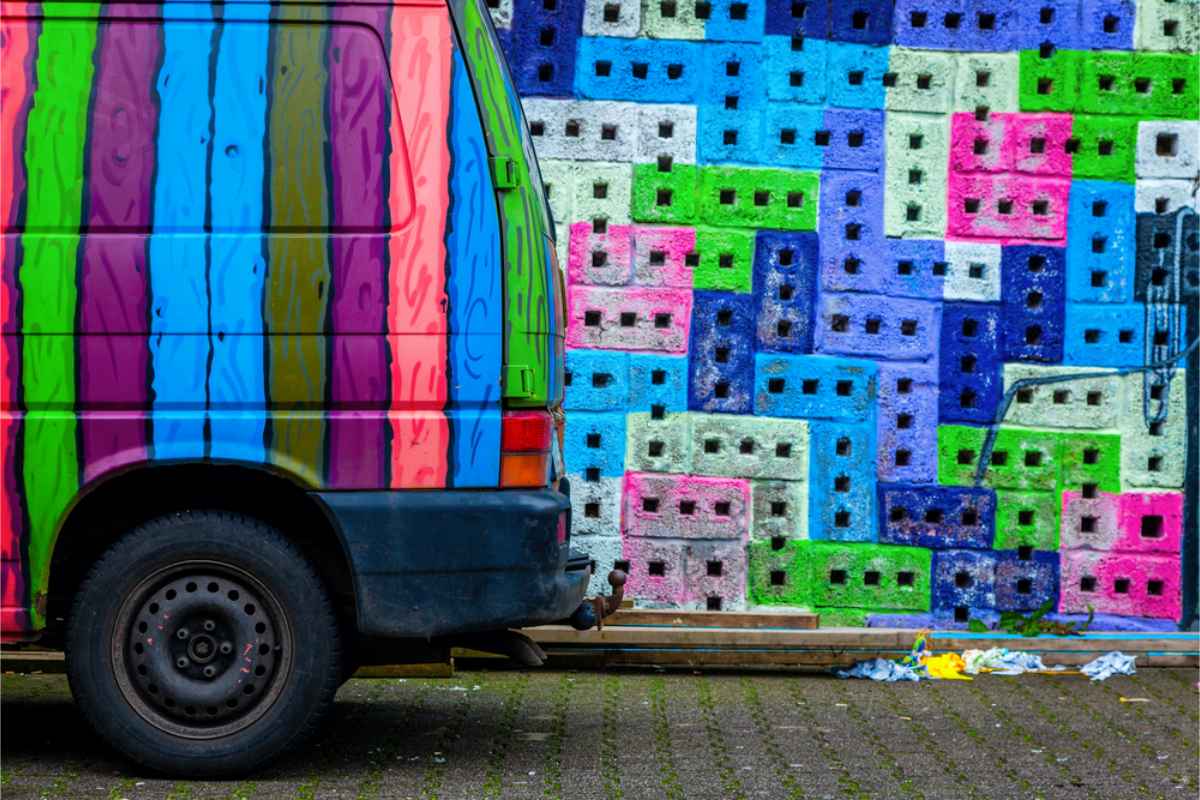
Street art is everywhere: whales, trolls, and political rants splashed on blank walls. If you’re too lazy to hunt for it yourself, a Reykjavík Street Art Tour does the scouting. But with your own car, you can zigzag between neighborhoods and find them without losing toes to the cold.
Food is where the car pays off. Skip puffin and whale meat menus downtown. Drive to Hlemmur Mathöll, a food hall where locals eat ramen, tacos, or lamb stew without tourist prices. For a sugar hit, Braud & Co. still rules with cinnamon buns warm enough to fog your windows. Coffee is a survival tool here, not a luxury.
Parking is simple with the Parka app. Pay near Hallgrímskirkja or Harpa, or park slightly outside and walk five icy minutes back in. Cheaper, faster, fewer headaches.
Where to Spot the Northern Lights by Car
Here’s where the rental car pays for itself. Northern Lights won’t show up if you stay under Reykjavík’s street lamps. You need dark skies, and buses only head to the same overcrowded pullouts. With a car, you choose.
Head west to Grótta lighthouse, just ten minutes from downtown. It’s close enough to test conditions, far enough for darker skies. If the aurora forecast looks promising, push farther: Thingvellir National Park offers wide valleys with zero light pollution. Or chase quiet roads along nearby fjords where no tours bother to go.
Flexibility is everything. Clouds shift by the hour. One valley can be blanketed, the next crystal clear. With your own wheels, you can keep moving until you find a hole in the sky.
Load up apps like Aurora Forecast and check Vedur.is for cloud cover. Bring a tripod if you care about photos, and dress for standing still in sub-zero cold.
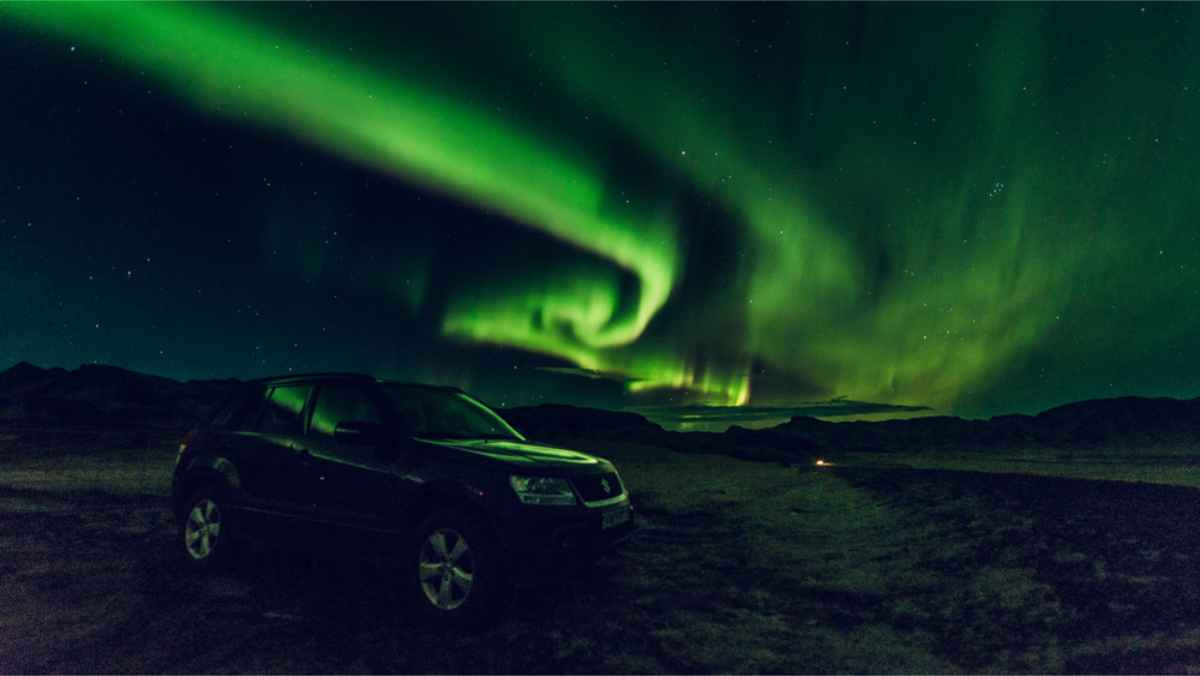
Day 3: Driving the Golden Circle
Any Icelandic 5-day winter itinerary has to include the Golden Circle. Yes, it’s popular, yes, buses roll through every day, but winter changes everything. Crowds thin, snow hushes the landscape, and those famous sights look twice as dramatic against a frozen backdrop. With your own car, you set the pace. You can get there early, linger longer, or skip the groups entirely.
Thingvellir National Park
First stop: Thingvellir (Þingvellir). This isn’t just another pretty valley. It is where the North American and Eurasian plates pull apart in slow motion. You can literally walk the crack between continents.
In winter, snow softens the trails, and cliffs glitter with frost. Paths stay open, but they turn slick, so bring real boots or microspikes. Entrance is free, though parking costs a few hundred ISK. Don’t skip Öxarárfoss, a waterfall that half-freezes into jagged ice curtains while water still crashes through.
Geysir Geothermal Area
Next is the Geysir geothermal field. The original geyser sleeps most of the time now, but Strokkur does the heavy lifting. Every 5 to 10 minutes, it blasts boiling water 20 to 30 meters (66 to 98 ft) high, steam rolling out over the snow.
In winter, the contrast is sharper: black ground, white snow, blue sky, then sudden eruption. Walkways are flat and obvious, just slick with ice. Entry is free, parking is close, and if you time it early or late, you avoid the bus loads.
Gullfoss Waterfall
A short drive brings you to Gullfoss, Iceland’s celebrity waterfall. Two tiers drop into a canyon, the lower one a 32-meter (105 ft) plunge that roars under a crown of ice. Spray freezes mid-air and coats everything it touches: rails, paths, jackets.
Safety rails often glaze over, so tread carefully. This is where self-driving matters. Arrive before the buses or after they leave, and the whole place feels like it belongs to you. Parking is free, which makes it even sweeter.
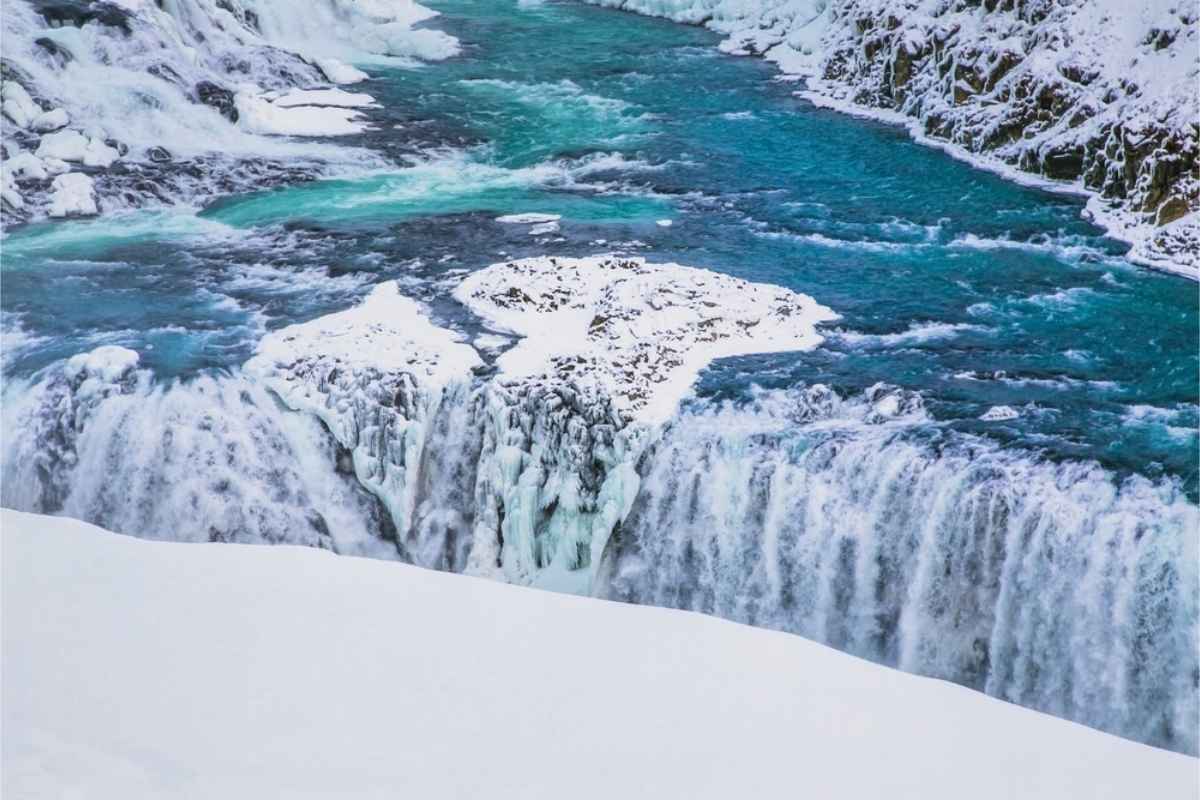
Friðheimar Greenhouse Lunch Stop
By this point, you will be frozen through. That is why Friðheimar Greenhouse feels like cheating. Outside is snow and wind. Inside are rows of tomato vines glowing under lamps in warm air.
The menu is simple: bottomless tomato soup and bread. Add a Bloody Mary, and suddenly you understand how Icelanders survive winter. The atmosphere is cozy, green, and a strange contrast to the white world outside.
It is popular, so book ahead. Soup is about 2,300 ISK, roughly 15 USD. Parking is on-site and easy. Best of all, you get here in your own car instead of with fifty strangers.
Day 4: South Coast Wonders and Ice Cave Tour
An Iceland in December itinerary always earns its stripes on the South Coast. This is where winter driving shows its teeth. Roads can be slick, winds brutal, and yet the rewards are the most dramatic sights you will see on the trip. Waterfalls rimmed in ice, beaches black as coal, and a glacier cave glowing blue from the inside.
Seljalandsfoss and Skógafoss Waterfalls
Start at Seljalandsfoss, about 130 km (81 mi) from Reykjavík. The waterfall drops 60 m (197 ft), and in winter the spray freezes into glittering icicle curtains that hang like glass. A path runs behind the falls, and if conditions allow, you can walk it for a surreal view from inside the cascade.
Even if the back path is closed, there’s more to see. Walk a short trail north and you’ll find Gljúfrabúi, a hidden waterfall tucked in a narrow canyon just 500 m (1,640 ft) from Seljalandsfoss. Few visitors bother, but it’s worth peering in through the mossy crack to see water plunge into a secret chamber.
Drive another 30 km (19 mi) east to Skógafoss. This one is bigger, a 62 m (203 ft) drop with a 25 m (82 ft) wide curtain of water. Winter spray freezes on the cliffs and stones around it, so the whole amphitheater shines. Don’t just stare from the bottom.
A staircase of 370 steps climbs the right-hand side to an upper platform, and from there you can trace the Skógá River upstream. Even in winter, the river valley holds dozens of smaller cascades, each rimmed with snow and ice. The hike is icy, so spikes are a smart choice.

Katla Ice Cave Tour from Vík
From Skógafoss, it’s a 30-minute drive to Vík, the jumping-off point for the Katla Ice Cave. Katla Tours start in town and continue by super jeep across black sand plains toward Mýrdalsjökull Glacier, which hides the Katla volcano beneath it.
Guides kit you out with helmets, crampons, and lights before leading a short glacier hike into the cave. Inside, walls of blue ice streaked with black volcanic ash rise like cathedral arches. You’ll spend 45-60 minutes exploring, long enough to take in the shifting colors as daylight filters through the ice.
While you’re in Vík, check the tiny Víkurkirkja church on the hill above town. The view back toward the ocean and the Reynisdrangar sea stacks is one of the South Coast’s most iconic winter panoramas.
Black Sand Beach at Reynisfjara
Just 10 km (6 mi) west of Vík lies Reynisfjara Beach. Black volcanic sand stretches out under snow-dusted cliffs, with basalt columns stacked like organ pipes. Offshore, the Reynisdrangar sea stacks rise 66 m (217 ft) from the Atlantic, sharp as broken teeth.
Most people stop for photos, but there’s more here. Walk toward the cliffs and you’ll see the cave-like hollow called Hálsanefshellir, framed by perfectly geometric basalt columns. Winter snow often piles against the black stone, creating a surreal chessboard effect.
Safety here matters. Sneaker waves strike without pattern, and the Atlantic’s pull is unforgiving. Stay well back from the surf and respect the warning signs. Parking is on-site and easy, giving you time to explore the cliffs and sea stacks at your own pace.
Day 5: Optional South Coast Stops and Return to Reykjavík
The last day of your Iceland itinerary for 5 days in winter is less about chasing bucket-list stops and more about enjoying the ride back to Reykjavík. After ice caves and frozen giants, Day 5 slows down. You’ve got panoramic cliffs, quiet villages, and roadside chapels half-buried in snow.
Dyrhólaey Viewpoint
Just 18 km (11 mi) west of Vík lies Dyrhólaey, a promontory of black cliffs that juts into the Atlantic. In summer, it’s famous for puffins, but in winter, it trades feathers for snow. From the top, you get a panoramic sweep of Reynisfjara’s black sands on one side and endless lava fields on the other. The sea arch that gave the headland its name is massive enough for small planes to have flown through.
The road up can be icy and steep, so a 4x4 is a smart bet. Parking is simple at the top, and the wind here is vicious, so dress like you plan to stand on a cliff in the North Atlantic because you are.
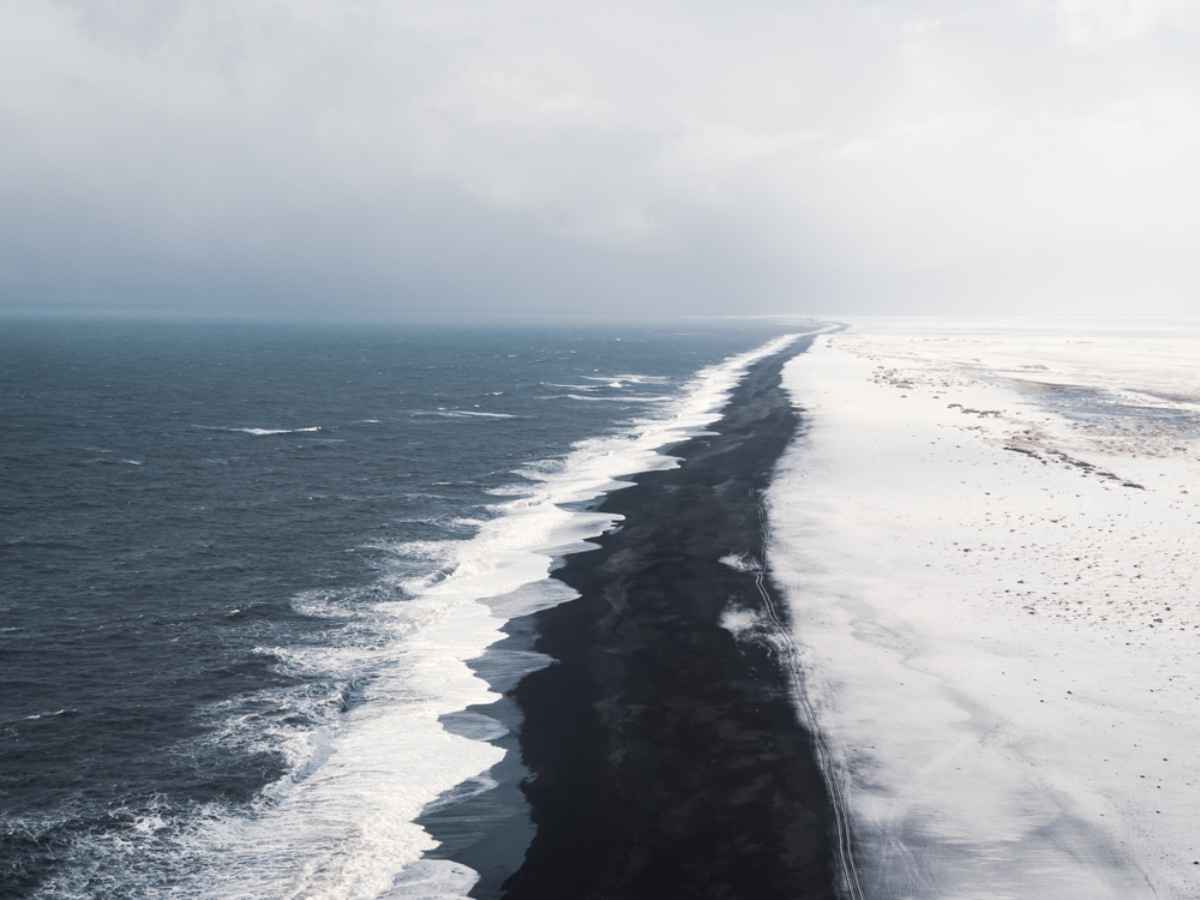
Drive Back with Scenic Stops
The drive west toward Reykjavík covers about 190 km (118 mi), but it doesn’t have to feel like a slog. Lava fields stretch for kilometers, frozen into rippling shapes that look like sculptures under snow. Stop once, take a walk, and you realize how quiet this part of the country really is.
Towns like Hvolsvöllur and Selfoss break up the drive. Both have cafés where you can grab coffee strong enough to fight off the dark, and shops where locals stock up before heading farther east. They are not tourist attractions, but they show the rhythm of daily life here.
Along the way, you will see roadside chapels, small wooden buildings painted red or white, standing out against the winter landscape. They make quick photo stops without pulling you far off the main road
Plan your route back around daylight hours. By evening, you’ll roll back into Reykjavík, closing the loop on the South Coast.
Bonus Add-Ons for Extra Time
If you have some extra time on your Iceland winter itinerary or want to extend your trip, then Iceland rewards you with detours that buses rarely manage. These add-ons push farther but pay off in spectacle.
Glacier Lagoon and Diamond Beach
Five hours from Reykjavík and two from Vík lies Jökulsárlón Glacier Lagoon. Icebergs the size of houses drift toward the ocean, breaking off Breiðamerkurjökull glacier. Across the road, Diamond Beach spreads black sand covered in stranded ice chunks, each glowing like a crystal in the low light.
It’s a long drive in winter, with the weather always a risk. But if conditions hold, it’s one of Iceland’s most surreal sights. Fuel up before leaving Vík and check road conditions for closures before committing.
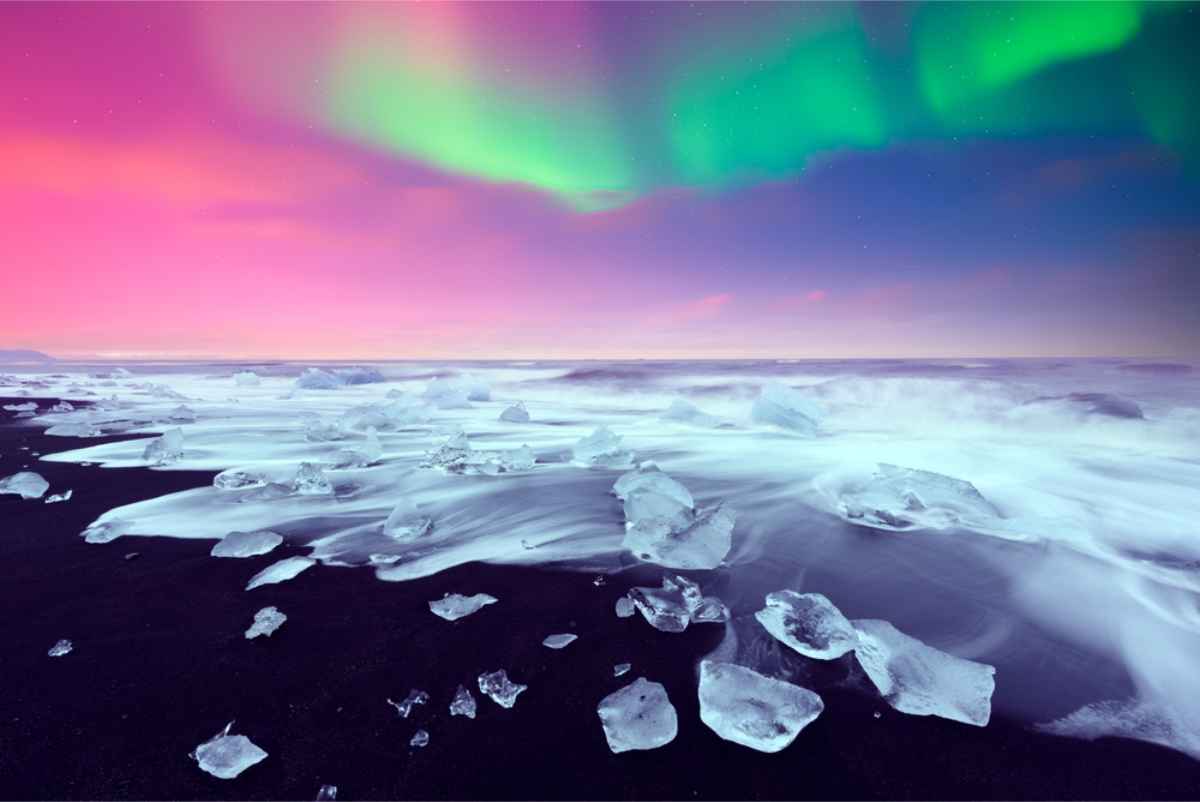
Secret Lagoon or Other Hot Springs
If you want hot water without the circus, head to the Secret Lagoon in Flúðir, about 100 km (62 mi) east of Reykjavík. It is smaller, older, and feels more rustic than the polished Blue Lagoon. Steam rises straight off the earth, and most of the people soaking here are Icelanders, not bus tours. The pool sits at a steady 38–40°C (100–104°F), warm enough to thaw you out even when the air is well below freezing.
Entry runs about 2,400 ISK (roughly 35 USD), and there are basic changing rooms and showers on-site. Parking is free, and in winter, the drive is simple if you already have a rental. Beyond Flúðir, almost every town in Iceland has a public pool or a local hot pot. Places like Hveragerði bubble with geothermal spots where you can soak for a fraction of the cost.
Where to Stay Each Night
Planning where to sleep on a trip of 5 days in Iceland in winter matters as much as the driving. Distances look short on the map, but winter conditions slow everything down. Having the right base each night saves hours and keeps the whole itinerary from turning into a grind.
Reykjavík Suggestions
Reykjavík has no shortage of places to crash, from family-run guesthouses to glossy downtown hotels. Guesthouses are usually cheaper and friendlier, often run by locals who will slip you tips on where to actually eat and what’s not worth your time.
The catch is parking. Many have none, and parking in Reykjavik is a sport you don’t want to play after a long winter drive. Always check before you book. Hotels make life easier if you are driving. Some offer on-site spaces, others cut deals with nearby garages.
It costs more, but having a guaranteed spot means you can ditch the car and still wander into Reykjavík’s food halls, bars, and museums without worrying about a meter running until 9 pm.
South Coast Suggestions (Vik, Hella, Hvolsvöllur)
When your itinerary takes you east, where you sleep matters; distances look short on the map, but winter slows everything down. Vík is the obvious base if Day 4 is about ice caves and black sand beaches.
The town has guesthouses, small hotels, and lodges that all come with parking and the relief of a hot shower after hours in the cold. If you would rather cut the drive in half, Hella and Hvolsvöllur make smart bases. Both sit closer to the Golden Circle and are useful when you are looping back north.
These towns are small, but you will find fuel, groceries, and a spread of countryside guesthouses or hotels. Most have winter-ready parking, which means you can roll out early or come back late without stressing about icy road conditions.
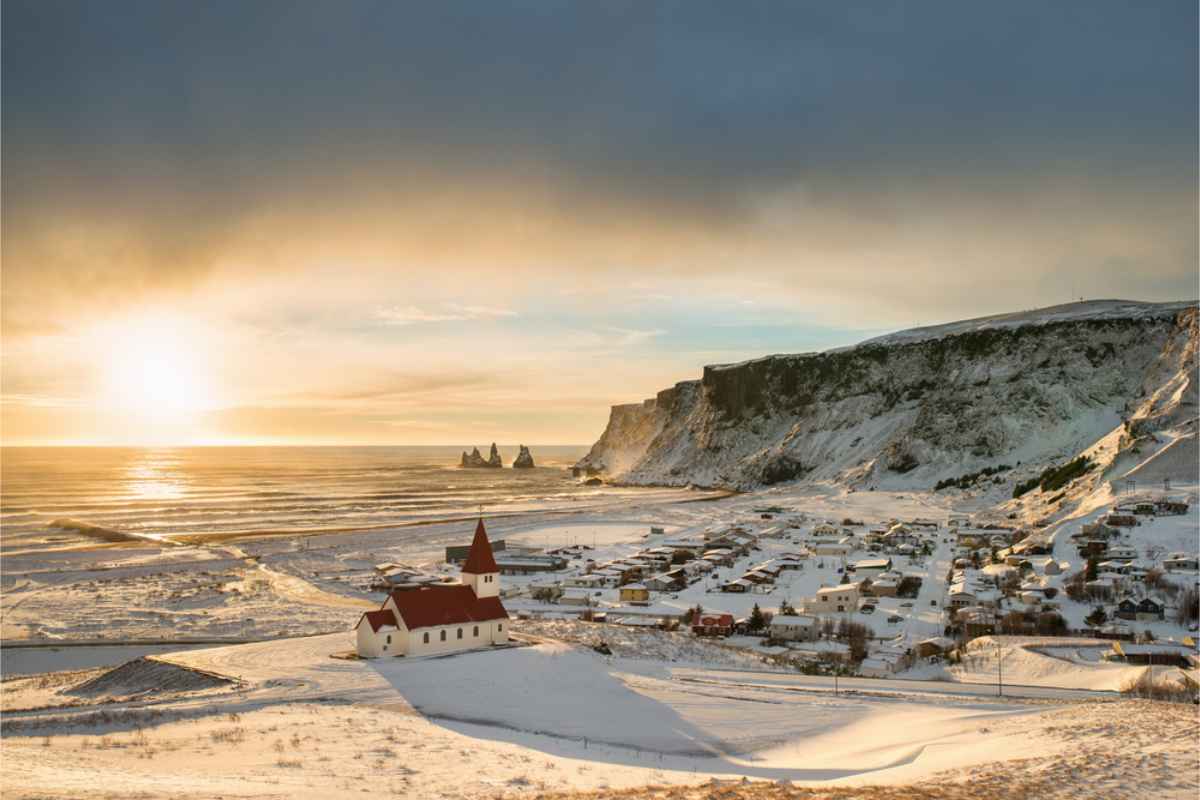
Final Tips Before Your Winter Road Trip
A winter in Iceland itinerary is only as good as your prep. Roads close, storms roll in fast, and fuel stations thin out once you leave the capital. The last thing you want is to end up stranded because you trusted luck instead of a little planning.
Fueling, Road Closures, and Weather
Top up the tank before any long leg. Out east, fuel stations in Iceland can be 70 to 100 km (43 to 62 mi) apart, and some close early in winter. Use Umferdin.is to update road closures and driving conditions in real time, so checking it each morning should be as routine as brushing your teeth. If conditions look ugly, sit tight and wait it out.
Apps and Tools for Safe Travel
Keep the right tools on your phone. Vedur.is gives weather forecasts you can trust, not just vague ‘snow showers.’ Umferdin.is covers road conditions in detail, with updates on ice, closures, and accidents.
Aurora apps help plan your Northern Lights chase, and Google Maps offline is a must when cell service vanishes in the countryside. Pack a charger and a power bank so your navigation and weather checks don’t die when you need them most.
Why This Iceland Winter Itinerary Works
An Icelandic winter itinerary sounds harsh, but it’s absolutely doable if you prepare. The roads demand respect, not fear. With the right car, you unlock everything: frozen waterfalls, ice caves, black beaches, and auroras over steaming pools.
Our fleet is built for this. Look early, book early, and lock in the vehicle that fits your route before someone else grabs it. Renting a car in Iceland is the move that makes this trip yours instead of a tour bus rerun. Take the wheel, own the story, and let winter test you. That’s half the fun.




